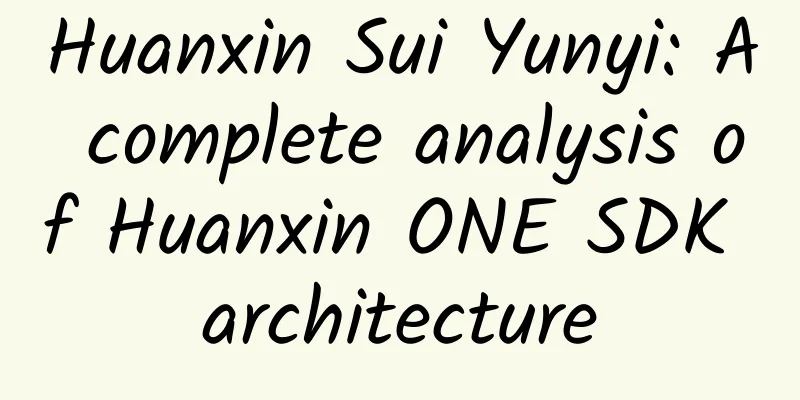Huanxin Sui Yunyi: A complete analysis of Huanxin ONE SDK architecture

|
HuanXin Instant Messaging SDK has been in use for a year since the official release of version 2.0 in June 2014. From basic single chat functions to group chat functions and then to the realization of chat rooms, the SDK is becoming more and more perfect and stable in terms of functionality, stability and ease of integration. We would like to thank the developers for their feedback and help, which has enabled our SDK to be rapidly improved and enhanced in many aspects. With the rise of the Internet of Things, HuanXin's current SDK architecture is still slightly insufficient to cope with future Internet of Things platforms, so we had to consider at the beginning of this year how to improve our architecture so that it can be more easily adapted to various mainstream platforms and Internet of Things platforms. Today's Android, IOS, and SDK all maintain their own logic, which brings a lot of inconvenience to 2.0 development. The same function requires maintaining two codes, and the same bug needs to be fixed twice on different platforms. Due to the implementation of different platforms, the Android and IOS architecture designs are not unified, and the APIs are inconsistent. In addition, there are many communication problems between engineers developing on different platforms due to different implementations. The problem caused by this is that the development progress of different platforms is different in most cases. Therefore, in response to the above problems, we planned the development of our SDK3.0 at the beginning of this year. We called it ONE SDK. The basic concept is that we realize a common IM kernel so that the code can be optimally reused on different platforms. However, the design and implementation are faced with huge challenges. How to adapt to different platforms and how to optimally reuse the code are the problems that we have to face. ONE SDK Architecture Design Overall Design The overall design of ONE SDK is divided into three layers: platform layer, porting layer, and common layer. The platform layer will implement different interfaces based on the differences of each platform and open APIs that conform to the platform layer to third-party developers. The adaptation layer mainly adapts to some interfaces required by the ONE SDK core layer, playing a connecting role. The core layer mainly provides IM functions and business logic to ensure maximum code reuse. Considering cross-platform code sharing, our ONE SDK is mainly implemented in the cross-platform language C++. Platform Layer The platforms we plan to support include Android, IOS, MAC OS, Windows, Windows phone, Linux, Embedded Linux, and the widely used IoT platform - IOT OS. We will provide developers with API specifications consistent with the platforms for different platforms, so that developers of each platform can integrate SDK without difficulty. For example, we will provide JAVA for Android, Objective-C for IOS and MAC, and C++ for Linux and IOT platforms. Adaptation Layer The adaptation layer mainly includes some interface classes required by each platform to implement the core layer, such as the thread model, timer model, database model, and HTTP model shown in the figure above. These models are all platform-dependent. For example, some platforms provide access to sqllite, while others do not. Some thread models and timer models have their own implementation methods, such as the Internet of Things (IOT OS). Therefore, by implementing the above models, the core layer can work. However, some problems may also be encountered, which will be specifically addressed in the specific implementation, but the structure is clear. In fact, for example, Android, Linux, IOS, Mac OS, and Windows all support C++11, which means they all support the thread model provided by C++11. Therefore, the implementation of the thread model of these operating systems should be the same, so the code can be shared. However, the database Anroid NDK does not support sqlite access, so there are two strategies for this part of Android. One is to integrate the sqlite source code, and the other is to call back to the JAVA layer. The former strategy has clear code logic, but the disadvantage is that it increases the amount of code. There is also the HTTP model. By default, Android, iOS, Mac OS, and Windows all have their own APIs. Therefore, the ONE SDK strategy is that if there is a platform with native HTTP API support, we will try to use the platform. However, similar to Linux, third-party library support is required, such as libcurl. So to sum up, the adaptation layer is of great significance, ensuring the maximum sharing of our ONE SDK code. Core Layer The core layer is the module that specifically implements HuanXin related functions. It also includes several parts, core business logic API implementation, abstract protocol layer, and independent real-time audio and video modules. Core Common The business logic layer is responsible for providing basic IM functions. Session management ·Message sending and receiving Login authentication Connection management Audio/Video Call The real-time audio and video module is an independent module that can exist independently, so that it can be handled flexibly and does not need to be loaded when not needed. Real-time audio and video Multi-person voice Abstract Protocol Layer The protocol abstraction layer is mainly used to process specific IM underlying protocols. This layer is relatively independent and mainly implements the IM transmission protocol defined by HuanXin. It also provides a connecting role for future protocol modification and expansion. Define abstract message carriers Basic message sending Basic message callback Define basic notifications The above ONE SDK architecture is what we plan to implement. Now some basic designs have been implemented on the Linux SDK. Let’s continue to learn about the Linux SDK. Linux SDK After several months of development, we have launched the Linux SDK beta version. Interested developers can try it out and download it from our official website http://www.easemob.com/downloads. Through the EMChatClient Facade class, developers can access any IM-disabled functions. Login and Register ·Message sending and receiving, supports TXT, IMAGE, VIDEO, AUDIO, FILE, LOCATION, type of message Session management Contact management When developing the Linux SDK, we took advantage of many excellent features provided by C++11, such as lambda, shared ptr, thread and other newer features. Through the use of these features, we were able to quickly and efficiently develop the Linux SDK test version. Lambda makes our code logic clearer to read, shared ptr makes our memory management simpler, and the use of thread enables us to quickly establish a thread model and speed up development. We implemented the thread model, database model, timer model and HTTP model in the Linux SDK porting layer Thread model, encapsulated using C++11 thread Database model, using Linux's sqlite HTTP model, we use Libcurl for encapsulation Timer model, we encapsulate it using C++11 We are still working intensively on the Linux SDK day and night. Group and real-time audio and video functions are still under development, but we have encountered some problems in the development process. For example, different Linux platforms have different support for libraries, so there will inevitably be some changes to our architecture. Some reconstruction work is also in progress. We hope to realize most of the functions by the end of August. The main reason for choosing Linux SDK as the starting point is that most embedded intelligent platforms are still based on Linux, so developing a Linux version of the SDK is also a necessary step. Thanks to our engineers, our Linux SDK can already support the development environment of Raspberry Pi, which is indeed good news for many developers. If you want to know how to integrate Linux SDK, please refer to Huanxin IM Linux SDK Integration Instructions Outlook Linux SDK is just the first step to realize our ONE SDK. In the second half of the year, we will also implement SDKs for Android, IOS, MAC OS, and mainstream IoT platforms based on ONE SDK. By drawing on the implementation method of Linux SDK, we believe that it is possible to realize ONE SDK. We will also further cooperate with major IOT platform suppliers to implement the HuanXin SDK for a specific IOT platform, making the HuanXin instant messaging platform ecosystem even stronger. |
<<: As coders, why do we write?
>>: These 15 key statistics are what all game developers need to know
Recommend
Brand Tmall Self-broadcasting Methodology
Brands’ self-broadcasting on Tmall presents both ...
Analysis of Tik Tok media advertising in Q1 2020!
Douyin’s DAU has exceeded 400 million, a 60% incr...
iQIYI’s high-quality barrage advertising operation process and advantages!
After summarizing the many characteristics of iQi...
How to choose Weibo advertising? I bet you know too little...
As we all know, when advertisers want to place ad...
Why are there more and more popular apps, but their popularity is getting shorter and shorter?
Changba, Moman Camera, Crazy Guess Picture, Face ...
Xiaomi and Huawei are almost breaking their heads for these parameters
Compared with the rapid growth of the mobile phon...
How to design a good consumer-oriented App product
This article is a product sharing article, mainly...
Should you upgrade to iOS15? Is your iPhone11 still popular?
For current Apple users, whether the new system i...
2022-A weekly report
2022- Weekly Report Resource Introduction: The Xi...
Why can’t Sogou’s bidding consumption be displayed even though there is sufficient balance?
Check the ad's enabled status, plan, unit, ke...
Automatic day and night change & full screen mini program! WeChat 7.0.3 is here
[[256644]] Recently, WeChat released version 7.0....
4 steps to quickly increase your conversion rate!
First of all, what is the growth we want to talk ...
3 operational thinking methods to beat e-commerce promotion campaigns (Part 1)
This article mainly summarizes the author's o...
How to create a hit on Douyin?
In July this year, the official TikTok revealed a...
Community operation methods and mainstream community types!
The main members of online fan communities are yo...









